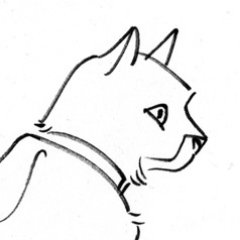@sleepysumairu @_Shekmate_ Yeah, this advice won't be relevant to every style. Proceed accordingly!
Quick'n'dirty water method:
1) Make a gradient. This can be grey, blue, green -- whatever color.
2) Scribble some water textures with white lines on a new layer.
3) Duplicate that layer; darken the textures and lower them to the pool bottom.
4) Pool toys!
For example, the unique visions of these artists are revealed by how they each chose to illustrate Alice meeting the Caterpillar. (Kei Acedera, Harry Rountree, Bessie Pease Gutmann, Ralph Steadman.) (2/2)
Drawing complex objects in 3D:
1 Draw the object flat
2 Use transform tool to angle it into desired perspective
3 Duplicate. Extrude/bring forward one layer at 50% opacity. Leave the back layer at 25% opacity.
4 Connect layers using lines that converge at a point.
5 Erase excess.
Accordingly, here's Norman Thelwell contrasting a grey mass of detail with white space, to isolate and draw attention to the speaking figures.
Here too: her eyes and boots look brown, but red is the only color used. The fewer colors you can use, the more unified and easily readable.
Don't underestimate the role of value (dark & light) in how colors appear. The outfit here reads as violet, despite only being red + grey.
Richard Corben was less experimental, using undergrounds instead to create sci-fi & horror with an explicitness forbidden to most comics.
Here are a couple of pages where assistants were almost certainly used. I'll highlight in red the parts the assistants likely drew.
@Yawgmothx Jon Bogdanove's work at Marvel in the '80s shows that Shooter appreciated good, simple, expressive cartooning like Henderson's.
























